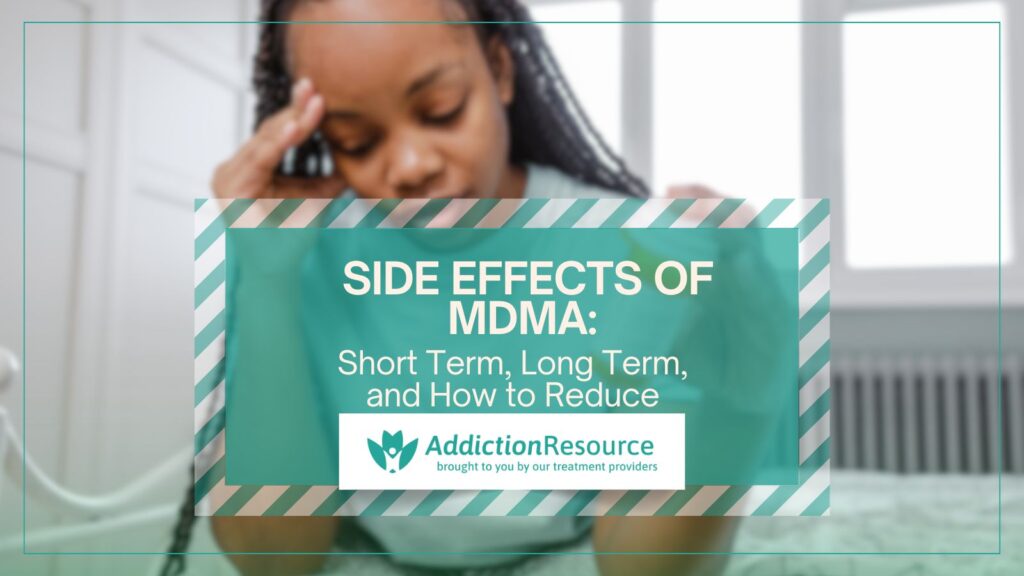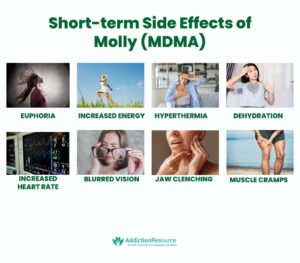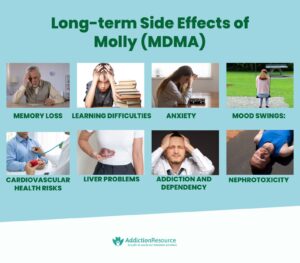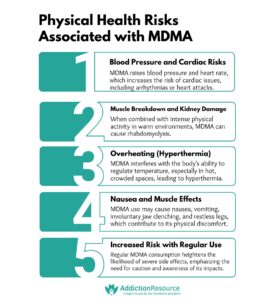
MDMA (3,4-methylenedioxymethamphetamine), known as ecstasy or molly, causes side effects such as paranoia, higher blood pressure, hallucinations, impulsiveness, and increased body temperature. Ecstasy is an illegal synthetic drug that affects the brain by altering serotonin levels, which disturbs mood, memory, and sleep cycle.
A person starts to feel the effects of MDMA about 20 minutes after taking a dose. These effects include heightened happiness, energy, alertness, and a sense of closeness to others. People report feeling more sensitive to lights, sounds, touch, and smells. The peak effects occur within 15 to 30 minutes and last around three hours on average, which leads to misuse.
Table Of Contents:
In the United States, an estimated 2.1 million people reported MDMA use in 2023, with about 45% experiencing adverse effects that range from mild to severe symptoms, according to the National Institute on Drug Abuse.
What are the Short-term Side Effects of Molly (MDMA)?
The short-term side effects of Molly (MDMA) are euphoria, increased energy, and hyperthermia (heatstroke risk). MDMA is considered the primary active ingredient in the illegal drug ecstasy. The 8 immediate side effects of Molly are listed below.
- Euphoria: MDMA creates intense feelings of happiness, described as euphoria. Ecstasy typically begins its onset of action about 20 minutes after taking the medication, with its duration of action lasting around 3 to 6 hours. During this period, people experience intense feelings of euphoria, which is considered a psychological side effect.
- Increased Energy: People taking Molly experience high energy levels and alertness, which make MDMA a popular choice in party environments and clubs. Taking it frequently leads to overexertion, which is a physical side effect, particularly on premises such as dance clubs and bars.
- Hyperthermia (heatstroke risk): Hyperthermia is a condition where the body’s temperature rises above the normal range due to some external factors. MDMA raises core temperature by releasing heat-producing hormones and reducing the body’s cooling capacity. The combination of MDMA use and crowded, warm environments such as music events leads to heatstroke, according to a 2024 article titled, “MDMA and other stimulants in hot environments” by the Department of Health, Victoria.
- Dehydration and electrolyte imbalance: MDMA, combined with intense activity, causes some people to consume a lot of water because of dehydration, raising the risk of electrolyte imbalance or brain enlargement and more serious complications such as hyponatremia (low sodium in the blood).
- Increased heart rate and blood pressure: MDMA stimulates the heart, leading to a temporary spike in heart rate and blood pressure, which is a physical side effect. It is very dangerous for people suffering from cardiovascular diseases. MDMA’s effects on the heart go beyond elevated blood pressure, according to a journal titled, “Ecstasy (3,4-methylenedioxymethamphetamine): Cardiovascular effects and mechanisms” by Diogo A. Fonseca, last updated in 2021.
- Blurred vision: Frequent usage of MDMA causes hallucinations and blurred vision. MDMA leads to ecstasy-induced optic disc swelling, which results in significant visual loss, according to a 2020 publication titled “Ecstasy-induced optic disc swelling” from the National Library of Medicine. Optic disc swelling is believed to stem from the drug’s neurotoxic effects, impacting the optic nerve and leading to severe and sometimes irreversible damage to vision.
- Jaw clenching: Jaw clenching, or “Bruxism,” is a physical side effect and is quite common with MDMA. People with the healthiest teeth experience enamel erosion and broken teeth, affecting young adults when they’re sleeping and causing severe levels of anxiety.
- Muscle cramps: Ecstasy, which is a psychoactive drug, shares properties with both amphetamines and hallucinogenic drugs. Muscle cramping and twitching are one of the short-term physical side effects of MDMA.
Hope Without Commitment
Find the best treatment options. Call our free and confidential helpline
Most private insurances accepted
What are the Long-term Side Effects of Molly (MDMA)?
The long-term side effects of Molly (MDMA) are memory loss, mood swings, and cardiovascular health risks. The 8 long-term side effects of Molly are written below.
- Memory Loss: Long-term exposure to MDMA causes serotonergic system toxicity in the brain, leading to memory loss. This system is responsible for memory functions. MDMA causes dose-dependent memory impairment, according to a journal titled, “Remembering Molly: Immediate and delayed false memory formation after acute MDMA exposure” by Lilian Kloft, last updated in April 2022.
- Learning Difficulties: Chronic use of MDMA leads to cognitive decline, which makes tasks that require focus and processing information harder. Due to disruptions in the normal brain system, MDMA causes damage to the neurons and nervous system.
- Anxiety and Depression: MDMA triggers long-term disturbances in mood patterns, including anxiety, paranoia (delusional belief), and depression. It is primarily because of serotonin depletion and changes in brain chemistry.
- Mood Swings: Mood swings are a psychological side effect for some people, leading to aggression, memory loss, difficulty focusing, sleeplessness, and a significant decrease in appetite. Frequent ecstasy use disrupts normal brain chemistry, causing extreme mood swings.
- Cardiovascular Health Risks: MDMA and similar amphetamines produce significant immediate impacts on cardiovascular physiology, which results in cardiotoxicity and a higher risk of heart-related deaths. MDMA triggers a heart attack by impairing the heart’s oxygen supply and resulting in tissue death. Most of the cases that have been reported have involved either additional substances, such as alcohol or cocaine.
- Liver Problems: Raising liver enzymes causes liver damage that eventually ends in liver necrosis. Liver injury ranges from acute fulminant liver failure that requires liver transplantation to the asymptomatic increase in liver function tests (LFT).
- Addiction and Dependency: Diagnosing ecstasy addiction is challenging, as the drug has no clear withdrawal symptoms and is used socially by young people. Prolonged use leads to both physical and psychological dependence.
- Nephrotoxicity: Seizures, excessive exertion, heat, or MDMA’s toxicity on muscle cells lead to acute kidney injury. Chronic MDMA use causes hyperphosphatemia (elevated phosphate levels), hyperuricemia (elevated uric acid levels), and myoglobinuria (excessive myoglobin).
What are the MDMA Effects on the Brain?
The MDMA effects on the brain are primarily psychological and emotional, including fatigue, depression, and anxiety. MDMA has a profound effect on brain chemistry by altering the levels of serotonin, a neurotransmitter responsible for regulating mood, emotions, and sleep patterns. Serotonin depletion is a significant side effect that causes feelings of poor mood, irritation, and even depression symptoms.
Regular MDMA usage causes anxiety and paranoia because it gradually disturbs the brain’s normal serotonin balance. Strong mood swings, increased emotional sensitivity, or hallucinations (perceiving things that aren’t there) are the effects of MDMA on the brain.
People experience emotional instability and mental exhaustion as a result of this disruption, which makes it difficult to process emotions correctly. Regular MDMA usage exacerbates these side effects, and there are long-term concerns of anxiety and persistent mood disorders.
What are the Physical Health Risks Associated with MDMA?
The physical health risks associated with MDMA are higher blood pressure, involuntary jaw clenching, nausea, vomiting, and restless legs. People with pre-existing cardiac diseases are particularly at risk because MDMA increases blood pressure and heart rate, which increases the risk of heart problems, including arrhythmias or even heart attacks.
Ecstasy, when paired with vigorous physical exercise in warm conditions, results in rhabdomyolysis (a severe breakdown of muscles). Toxins released by this muscle breakdown damage the kidneys and cause acute renal failure. Another major risk of MDMA is overheating, or hyperthermia, which occurs in hot, crowded places such as clubs and music events because MDMA interferes with the body’s capacity to regulate temperature.
Dehydration, electrolyte abnormalities, and stress on the kidneys and cardiovascular system result from untreated hyperthermia. The significance of being aware of and cautious about MDMA’s effects on the body is highlighted by the fact that these physical side effects are particularly higher with regular use of MDMA.
How to Reduce MDMA Side Effects?
To reduce MDMA side effects, stay hydrated and take breaks while working. It’s important to stay hydrated, but avoid going overboard because doing so results in electrolyte imbalances. Balance is maintained by consuming tiny amounts of water or electrolyte drinks throughout the night.
Controlling body temperature is important, particularly because MDMA increases core temperature. One way to avoid overheating and lower the risk of hyperthermia is to take occasional breaks from dancing or relocate to cooler locations. Prioritizing healing is important after taking MDMA. The body’s natural balance is restored with the help of rest, a healthy diet, and enough water.
How to Handle MDMA Withdrawal?
To handle MDMA withdrawal symptoms, look for the signs of MDMA withdrawal and the detoxification process in order to manage withdrawal symptoms. When someone quits using MDMA after using it repeatedly, they experience mental and physical symptoms as their body readjusts. MDMA does not induce severe physical withdrawal symptoms like some other narcotics do, but psychological withdrawal symptoms are difficult.
Fatigue, mood fluctuations, impatience, trouble focusing, anxiety, and depressive symptoms are some withdrawal symptoms of MDMA. Self-care techniques, including getting enough sleep, drinking lots of water, and eating well-balanced meals, are used to manage these symptoms.
What is Molly (MDMA)?
MDMA (Molly or Ecstasy) is a synthetic drug developed in a lab that has effects similar to those of stimulants such as methamphetamine. Some researchers and organizations classify MDMA as a psychedelic substance because it changes perceptions of time and vision, according to the National Institute of Drug Abuse.
While ecstasy is the pill version of MDMA, which has a variety of chemicals, molly is advertised as the “pure” form of the drug, while it contains other compounds. MDMA, which was first created in the early 20th century, has become popular as a recreational drug, particularly at parties and clubs. Because of its effects on the body and brain, MDMA is prohibited in many countries, and using it carries serious side effects on one’s physical and mental health.
What Does Molly Look Like?
Molly looks like a white or off-white crystalline powder or in capsules. Ecstasy is typically available in tablet form, with various colors and imprinted logos.
Can You Smoke Molly?
No, you can not smoke Molly due to its chemical composition. MDMA is not heat-stable and decomposes when exposed to high temperatures, breaking down into potentially toxic byproducts instead of vaporizing.
Is Ecstasy Dangerous?
Yes, Ecstasy is dangerous due to its effects on the heart, brain, and body, particularly when used in high doses or mixed with other substances.
How Long Does Molly Take to Kick In?
Molly takes 20 to 40 minutes to start its onset of action after ingestion in tablet form. If snorted (insufflated), the onset is much faster and takes 5 to 10 minutes. In intravenous injection, the onset is within 0 to 2 minutes, producing the most intense effects.
How Long Does Molly Last?
The effects of Molly last between 3 to 6 hours, depending on the dose and individual factors. The effects are milder and last around 3 to 4 hours for a low 50 – 70 mg dose. A standard recreational dose of 75–125 mg results in effects lasting 4 to 6 hours, while higher doses of 150–200 mg or more lead to more intense effects that may extend up to 6 to 8 hours. Body weight and metabolism influence how quickly MDMA is processed, with those having a lower body weight or slower metabolism experiencing longer effects.
Can MDMA Cause Hematoma?
Yes, MDMA use leads to bruising or hematoma due to its potential effects on blood clotting and physical overexertion.
Can MDMA Lead to Overdose or Death?
Yes, MDMA leads to overdose and a high risk of fatal outcomes, including hyperthermia, Hyponatremia (water intoxication,) and cardiac complications when combined with overheating, or other substances.
Are MDMA Side Effects Similar to Other Stimulants?
Yes, MDMA side effects are similar to other stimulants, but there are some major differences. Similar to stimulants such as cocaine and crystal meth, MDMA increases energy and alertness while raising body temperature, blood pressure, and heart rate. But unlike these stimulants, MDMA intensifies emotions of emotional intimacy and empathy, a phenomenon known as empathogenic effects. Crystal meth and cocaine are more likely to produce strong, instantaneous exhilaration and are extremely addictive, resulting in rapid dependence.
Can MDMA and Cocaine both cause serotonin depletion?
Yes, MDMA and cocaine both cause serotonin depletion, but MDMA has a stronger effect. MDMA primarily targets serotonin, causing a large release and resulting in depletion that leads to mood swings, depression, and anxiety in the days after use. Cocaine affects serotonin but has a milder impact, as it influences multiple neurotransmitters, including dopamine and norepinephrine.
Is there a greater risk of overdose with MDMA compared to crystal meth?
No, the risk of overdose with MDMA is lower than with crystal meth, but both carry serious health risks. Crystal meth’s high potency and longer duration increase overdose potential, due to repeated dosing. MDMA overdoses are less common and life-threatening, due to dehydration, overheating, or mixing with other substances.
Hope Without Commitment
Find the best treatment options. Call our free and confidential helpline
Most private insurances accepted
Find Drug Rehabilitation Centers Near You Anywhere In the US
Addiction Resource team has compiled an extensive list of the top drug rehabilitation facilities around the country. Use our locator tool to find the best centers near you.


 Reviewed by:
Reviewed by: 




 FindTreatment.gov
FindTreatment.gov